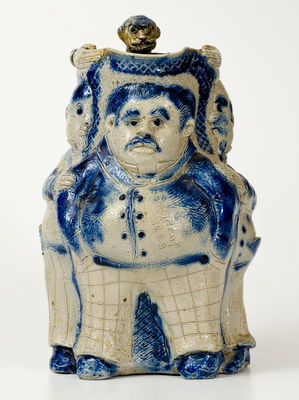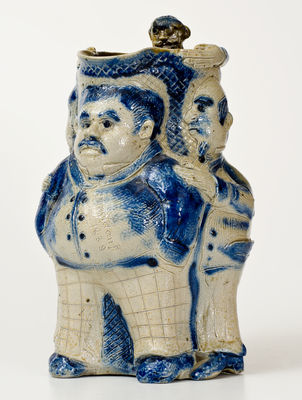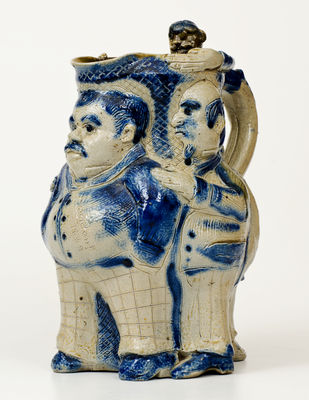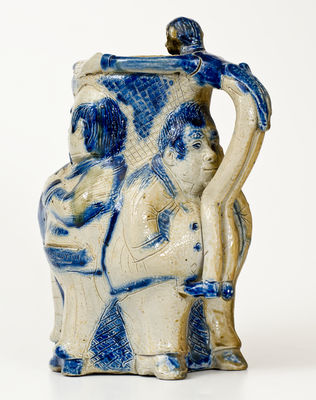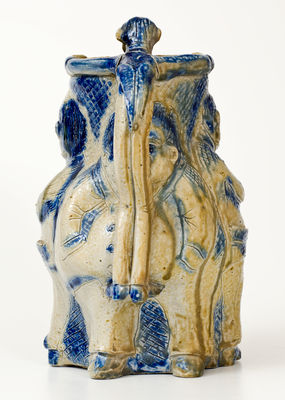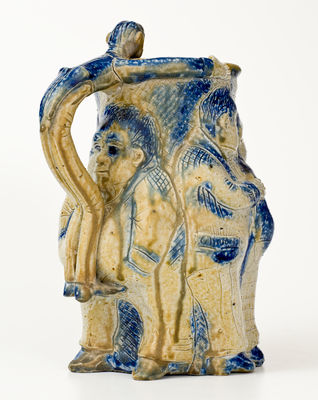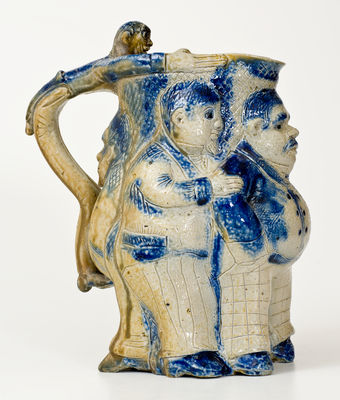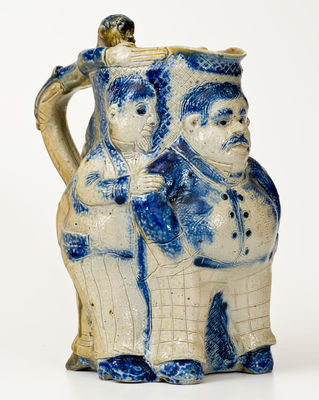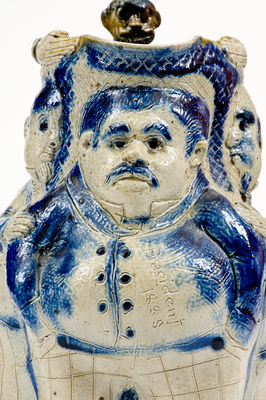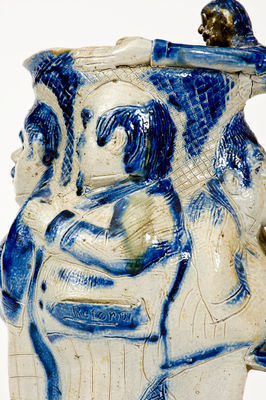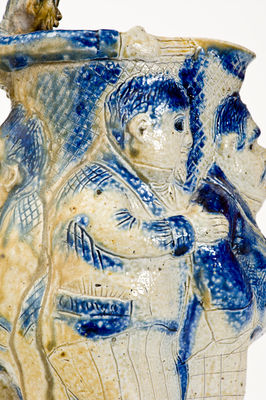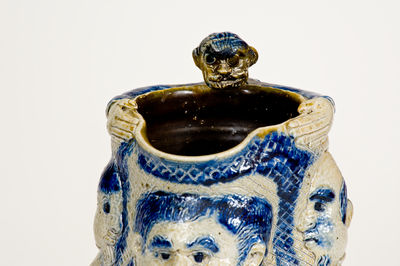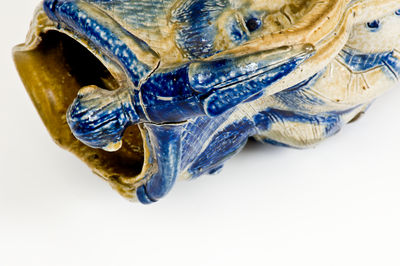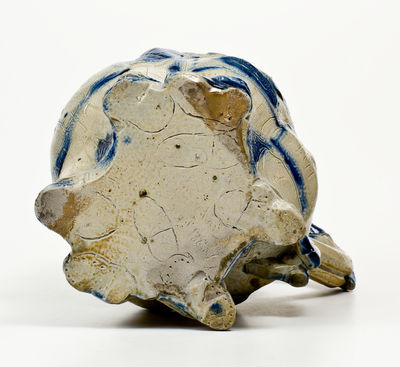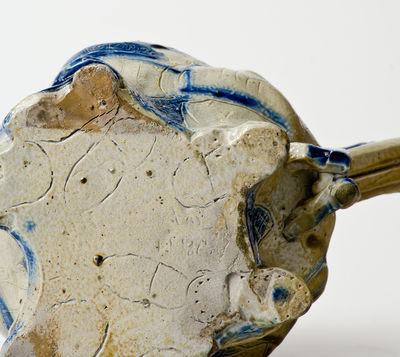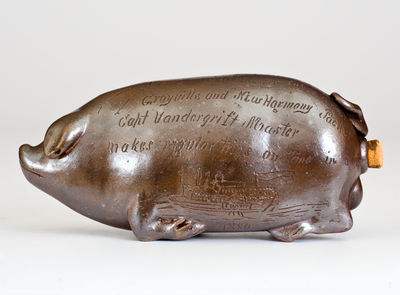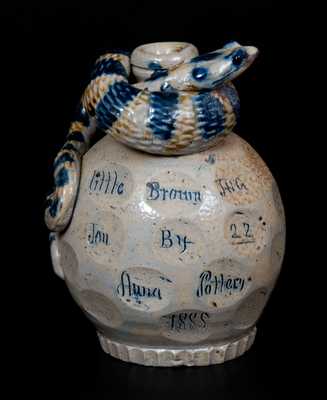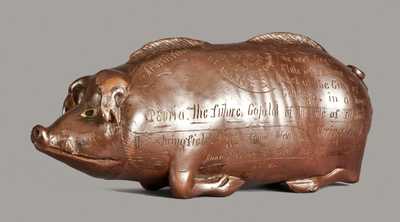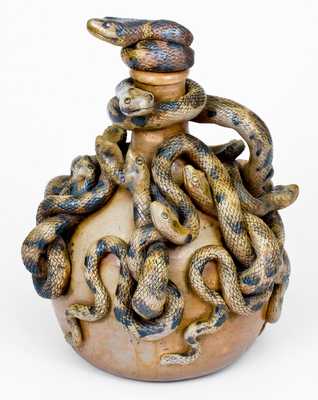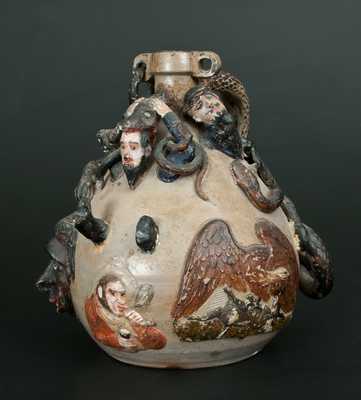Highly Important Cobalt-Decorated Stoneware Grover Cleveland Pitcher, Signed and Dated "Anna Pottery / January 15, 1885," Wallace and Cornwall Kirkpatrick, Anna, IL, 1885, wheel-thrown, ovoid-bodied pitcher with wide pouring spout, extravagantly decorated around the body with a sculpted figure of President Grover Cleveland flanked by three other figures. Cleveland assumes a confident pose with coiffed hair and hands tucked in his pockets, wearing a double-breasted suit and checkered pants, his chest emblazoned with the incised title, "President / 1885." Two goateed figures flanking the president grab his shoulder and whisper in his ear, one with open jacket pocket, inscribed "CHANGE," the other also with jacket pocket opened and inscribed "REFORM." Both images follow the Kirkpatricks' oft-repeated commentary on American political corruption and the idea of money buying power. A clever pun on the word, "CHANGE"--as in pocket change AND social change--is used. A fourth, subtly-smiling goateed figure with hands plunged deep in his pockets appears on the reverse. The figures are surrounded by profuse crosshatching, as seen on the Kirkpatricks' snake jugs and other forms, obsessively filling the negative space around the applied designs. The handle is modeled in the form of a sinuous, coat-tailed man with slicked hair and googly eyes, inscribed "Ex Sec / Interior," referring to Carl Schurz, Secretary of the Interior under Rutherford B. Hayes and one of the prime figures actively working to convince Republicans to vote for the Democrat Cleveland. One of the leaders of the so-called "Mugwumps" (Republicans who repudiated their presidential nominee, James G. Blaine, in favor of Cleveland), Schurz undertook an extensive speaking tour in 1884, one that took him into Illinois; of note for the Kirkpatricks' depiction of him, Schurz's speech in Rockford, Illinois, in September 1884 prompted the local Gazette to claim that he, "Like His Speeches, is Long and Thin." As Republicans who either supported Cleveland or at the very least cynically viewed the election of 1884, Schurz was a figure that would have heavily interested the Kirkpatricks; even more so his affiliation with Thomas Nast, the famous Harper's Weekly cartoonist who was himself part of the "Mugwump" faction and a major influence on the brothers. The underside of the pitcher is lightly incised with the signature and date, "Anna Pottery / January 15, 1885." Brushed cobalt slip decorates the details of the figures' faces and clothing and highlights the surrounding areas. The exterior surface is covered in a salt glaze. The interior is coated in Albany slip. Beautifully glazed and fired, the pitcher features exceptional color and luster to the clay and cobalt. The craftsmanship of this work is unprecedented in the American stoneware medium outside of the Kirkpatricks' shop. The pitcher's over-the-top decoration in the round, blanketing the surface (even the handle) with human forms against a heavily-incised ground, define it as one of the most elaborate creations by these celebrated ceramicists. The decorative process involved in the creation of the figures is interesting. After the pitcher was thrown, the interior wall of the vessel was pressed outward to loosely form the heavy-set figures around its body. Clay was then added, modeled, and incised to form the finished designs. A remarkable attention to detail can be seen throughout, in the facial expressions of the figures, the carved and incised shoes (down to the soles and heels), the varied patterns on the figures' pants, and the incised wrinkling throughout the clothing. Heavy incising--either combed, crosshatched, or singly etched--gives form to the swelled proportions of the already high-relief figures; such details, often complemented with cobalt slip highlights, can be seen on the outer edges of Cleveland's torso, accentuating his corpulent frame and tightly-fitting jacket. Artistic touches of this level of sophistication are something seen in the work of academically-trained artists and (one would assume) not country potters. This painstakingly-crafted work typifies the Kirkpatrick brothers' mastery of the medium and unique style, which boldly straddles the line between folk and fine art, the useful and the decorative. Ranking as a masterwork within the duo's oeuvre of extraordinary clay creations, this object also survives as one of the greatest American ceramic pitchers in existence. Exhibited: "The Kirkpatricks' Pottery At Anna, Illinois," Krannert Art Museum, Urbana-Champaign, Illinois, October 3-November 9, 1986; "The Kirkpatricks' Pottery At Anna, Illinois," State of Illinois Art Gallery, Chicago, Illinois, January 19-March 6, 1987; "The Kirkpatrick's Pottery at Anna, Illinois," Illinois State Museum, Springfield, Illinois, March 21-May 3, 1987; "Art From the Earth: Folk Designs in American Ceramics, 1780-1880," The Brandywine River Museum Antiques Show, Chadd's Ford, Pennsylvania, May 26-August 19, 1990. Literature: Ketchum, William C. Jr., "The Pottery & Porcelain Collector's Handbook: A Guide to Early American Ceramics From Maine to California," 1971, pp, 90-93; Felts, James K, Sr., "The Anna Pottery," Chicago History, No. 3, (Spring-Summer, 1974) pp. 36-44; Denker, Ellen Paul, "Forever Getting Up Something New: The Kirkpatrick's Pottery at Anna, Illinois 1859-1896," University of Delaware Thesis, June 1978; Prokopoff, Steven and Denker, Ellen Paul, "The Kirkpatrick's Pottery At Anna Illinois," Krannert Art Museum, University of Illinois, Urbana-Champaign, IL, 1986, p. 23; Ohara, Virginia H., "Art From the Earth: Folk Designs in American Ceramics, 1780-1880," Brandywine River Museum, 1990, fig. 18; Mohr, Richard D., Pottery, Politics, Art: George Ohr and the Brothers Kirkpatrick, p. 40, fig. 24. Provenance: Acquired by the consignor from a Kirkpatrick family descendant in 1985. Excellent condition with a minor chip to one figure's jacket pocket. H 11 3/4".

